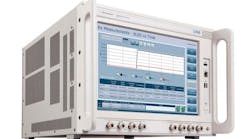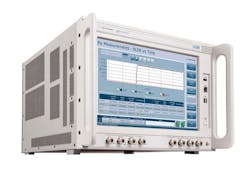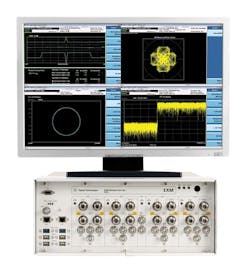This file type includes high resolution graphics and schematics when applicable.
Wireless communications devices continue to evolve, with designers attempting to keep pace with customer’s demands for increasing data uplink and downlink rates over limited swaths of available bandwidth. For testing newer wireless devices, such as Fourth-Generation (4G) and Long-Term-Evolution-Advanced (LTE-A) cellular communications systems, Agilent Technologies has launched two families of highly integrated, flexible test sets. The UXM and EXM series of wireless testers—which are essentially capable of substituting for different 4G and LTE-A wireless networks and systems—enable testing of wireless devices, components, and systems under real-world operating conditions through 6 GHz.
The UXM wireless test set include the model E7515A (Fig. 1), with a large, 15-in. touchscreen to simplify data entry and programming control. The UXM test set may be configured for two independent 100-MHz-wide RF transceivers and can use a wide range of test libraries by means of backwards-compatible SCPI. They can perform signaling and non-signaling tests, effectively recreating operating environments with multiple cells, with carrier aggregation, multiple-input, and multiple-output (MIMO) system configurations to 4×2.
The UXM test set is designed to test complex handover scenarios with VoLTE support, making it possible to verify bidirectional category-6 performance levels at downlink rates to 300 Mb/s and uplink rates to 50 Mb/s. They can also simulate a wide range of real-world conditions by introducing noise and impairments such as signal fading. Their integrated design reduces benchtop complexity and makes it easier for the test engineer to find design issues quickly and more accurately.
The UXM test set has built-in servers to support a wide range of test functions and capabilities. The testers include multiple expansion slots and upgradeable processors to evolve as wireless communications devices continue to change and grow. To speed creation of automated test routines, the UXM wireless test set works with the firm’s Wireless Test Manager (WTM) software to quickly adapt to changing wireless conditions. The WTM software, for example, can program testing for the full range of Third-Generation-Partnership-Program (3GPP) wireless channel configurations.
The EXM wireless test set includes variants of the model E6640A modular unit, suitable for production and manufacturing testing (Fig. 2). The scalable system is suitable for testing 2G, 3G, LTE, LTE-A, Bluetooth, and wireless-local-area-network (WLAN) products and devices. With as many as four transceiver channels, each EXM tester can perform parallel testing of wireless devices to speed production testing. A number of product model variations are available for different frequency ranges, such as model E6640A-504 for 380 MHz to 3.8 GHz (for cellular communications testing); model E6640A-5WC for 1.1 to 1.8 GHz, 2.3 to 2.6 GHz, and 4.8 to 6.0 GHz (for WLAN testing); and model E6640A-506 for wideband use from 380 MHz to 6 GHz. Measurement bandwidths of 40, 80, or 160 MHz are available.
The EXM wireless test set delivers absolute level accuracy of ±0.5 dB from 0.38 to 3.80 GHz, with a wide transmit output-power range extending from -120 to +5 dBm for frequencies from 380 MHz to 6 GHz. The EXM receivers achieve typical error-vector-magnitude (EVM) performance of -42 dB for 160 MHz IEEE 802.11ac testing. These scalable modular test sets can directly connect as many as 16 devices under test (DUTs) for fast-sequenced, non-signaling testing and as many as 32 DUTs with customizable MPA technology. Both the UXM and EXM test sets provide the modularity and flexibility to evolve as test requirements change, whether in the research laboratory or on the production floor.
Agilent Technologies, 5301 Stevens Creek Blvd., Santa Clara, CA 95051; (408) 345-8886.
This file type includes high resolution graphics and schematics when applicable.



